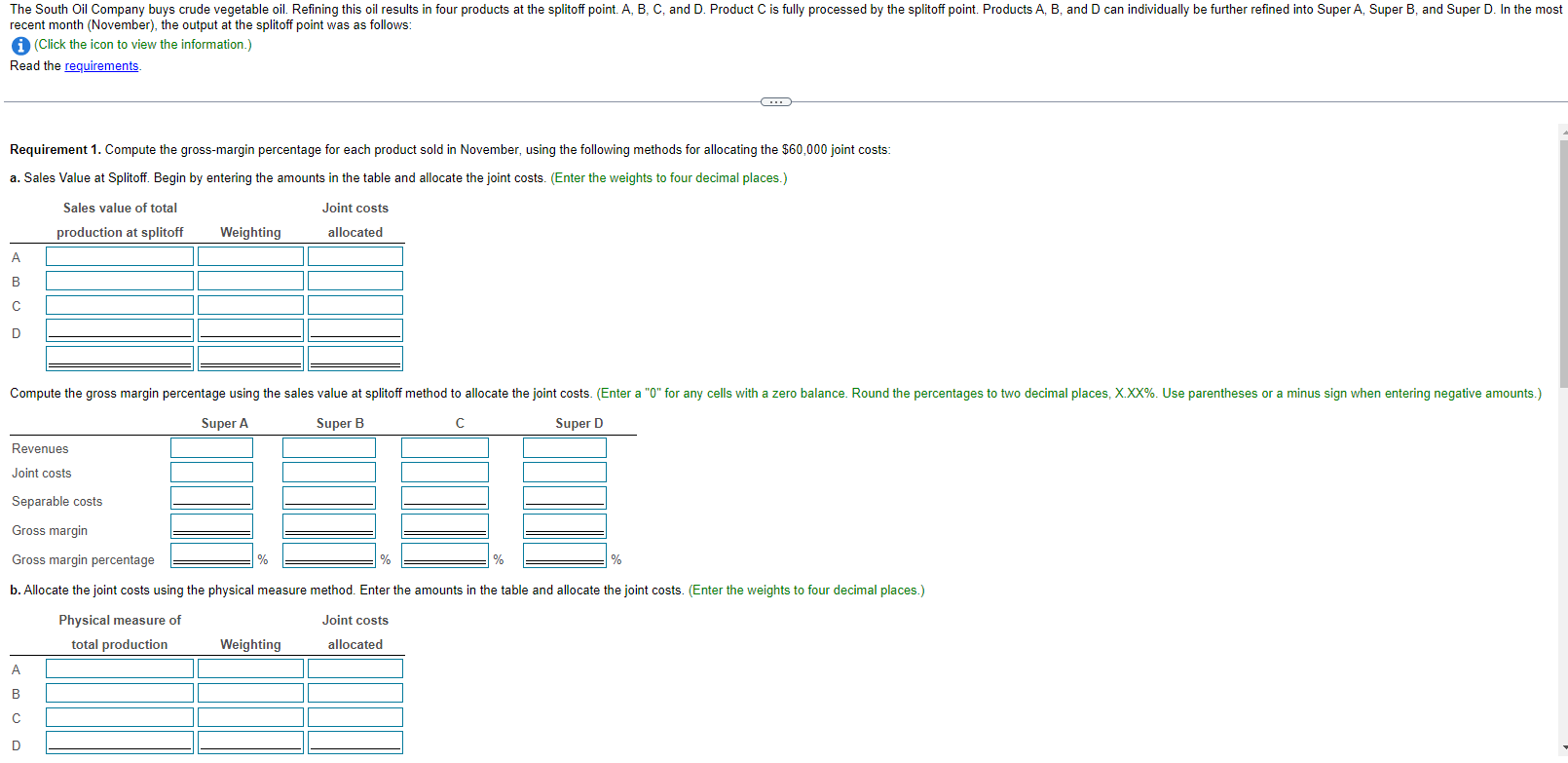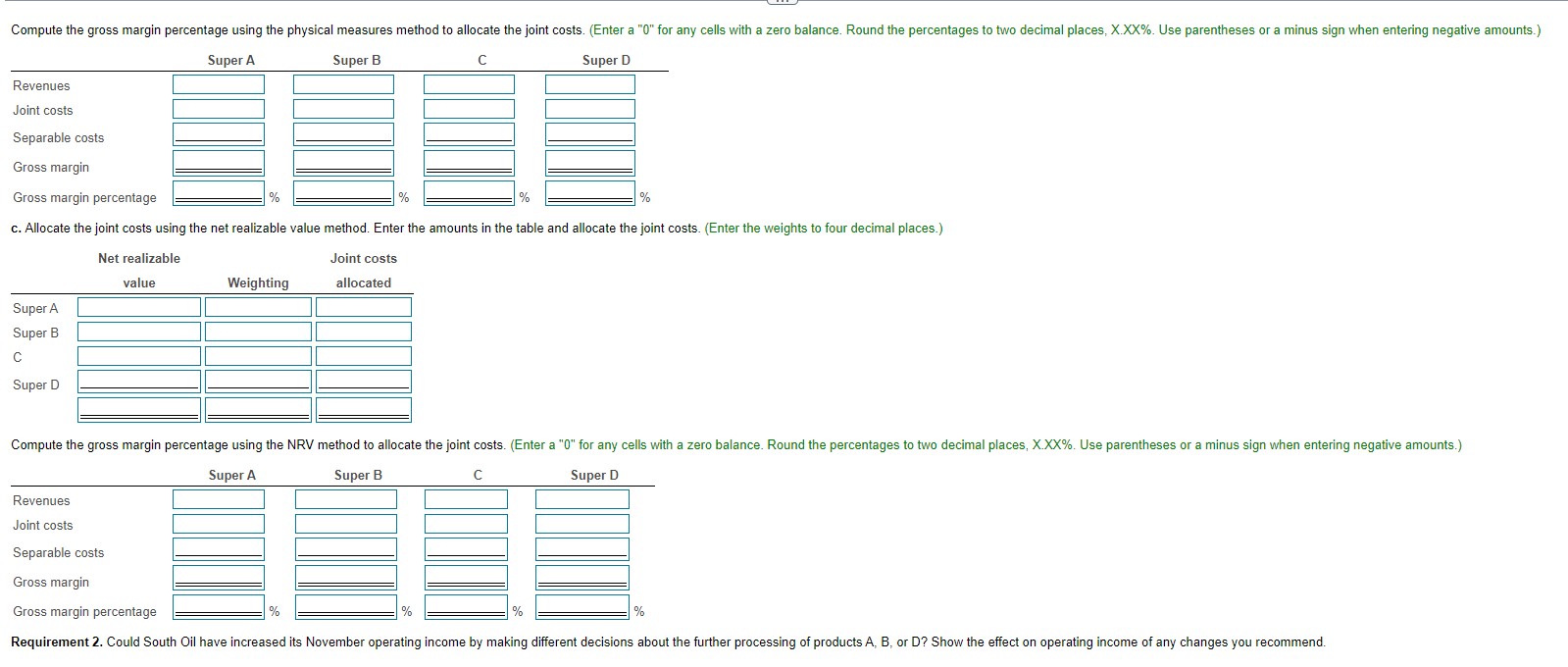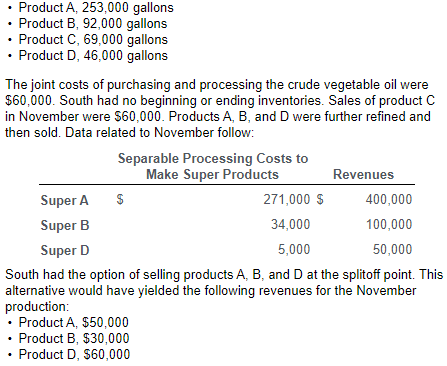Answered step by step
Verified Expert Solution
Question
1 Approved Answer
The South Oil Company buys crude vegetable oil. Refining this oil results in four products at the splitoff point. A, B, C, and D.




The South Oil Company buys crude vegetable oil. Refining this oil results in four products at the splitoff point. A, B, C, and D. Product C is fully processed by the splitoff point. Products A, B, and D can individually be further refined into Super A, Super B, and Super D. In the most recent month (November), the output at the splitoff point was as follows: (Click the icon to view the information.) Read the requirements. Requirement 1. Compute the gross-margin percentage for each product sold in November, using the following methods for allocating the $60,000 joint costs: a. Sales Value at Splitoff. Begin by entering the amounts in the table and allocate the joint costs. (Enter the weights to four decimal places.) Sales value of total Joint costs allocated production at splitoff Weighting A B C D Compute the gross margin percentage using the sales value at splitoff method to allocate the joint costs. (Enter a "0" for any cells with a zero balance. Round the percentages to two decimal places, X.XX%. Use parentheses or a minus sign when entering negative amounts.) Super A Super B Super D Revenues Joint costs Separable costs Gross margin Gross margin percentage % % % % b. Allocate the joint costs using the physical measure method. Enter the amounts in the table and allocate the joint costs. (Enter the weights to four decimal places.) Physical measure of total production Weighting A C D Joint costs allocated Compute the gross margin percentage using the physical measures method to allocate the joint costs. (Enter a "0" for any cells with a zero balance. Round the percentages to two decimal places, X.XX%. Use parentheses or a minus sign when entering negative amounts.) Super A Super B C Super D Revenues Joint costs Separable costs Gross margin Gross margin percentage % % % % c. Allocate the joint costs using the net realizable value method. Enter the amounts in the table and allocate the joint costs. (Enter the weights to four decimal places.) Super A Super B Super D Net realizable value Weighting Joint costs allocated Compute the gross margin percentage using the NRV method to allocate the joint costs. (Enter a "0" for any cells with a zero balance. Round the percentages to two decimal places, X.XX%. Use parentheses or a minus sign when entering negative amounts.) Super A Super B C Super D Revenues Joint costs Separable costs Gross margin Gross margin percentage % % % % Requirement 2. Could South Oil have increased its November operating income by making different decisions about the further processing of products A, B, or D? Show the effect on operating income of any changes you recommend. Requirement 2. Could South Oil have increased its November operating income by making different decisions about the further processing of products A, B, or D? Show the effect on operating income of any changes you recommend. Determine the formula you will use to make your decision. Then enter the amounts for each product and determine the effect on operating income of the decision. (Enter negative effects with parentheses or a minus sign.) A B Operating income can be increased by point rather than processed further. Effect on operating income from further processing is/are sold at the splitoff Product A, 253,000 gallons Product B, 92,000 gallons Product C, 69,000 gallons Product D, 46,000 gallons The joint costs of purchasing and processing the crude vegetable oil were $60,000. South had no beginning or ending inventories. Sales of product C in November were $60,000. Products A, B, and D were further refined and then sold. Data related to November follow: Separable Processing Costs to Make Super Products Super A $ Super B Super D Revenues 271,000 $ 400,000 34,000 100,000 5,000 50,000 South had the option of selling products A, B, and D at the splitoff point. This alternative would have yielded the following revenues for the November production: Product A, $50,000 Product B, $30,000 Product D, $60,000
Step by Step Solution
There are 3 Steps involved in it
Step: 1

Get Instant Access to Expert-Tailored Solutions
See step-by-step solutions with expert insights and AI powered tools for academic success
Step: 2

Step: 3

Ace Your Homework with AI
Get the answers you need in no time with our AI-driven, step-by-step assistance
Get Started


